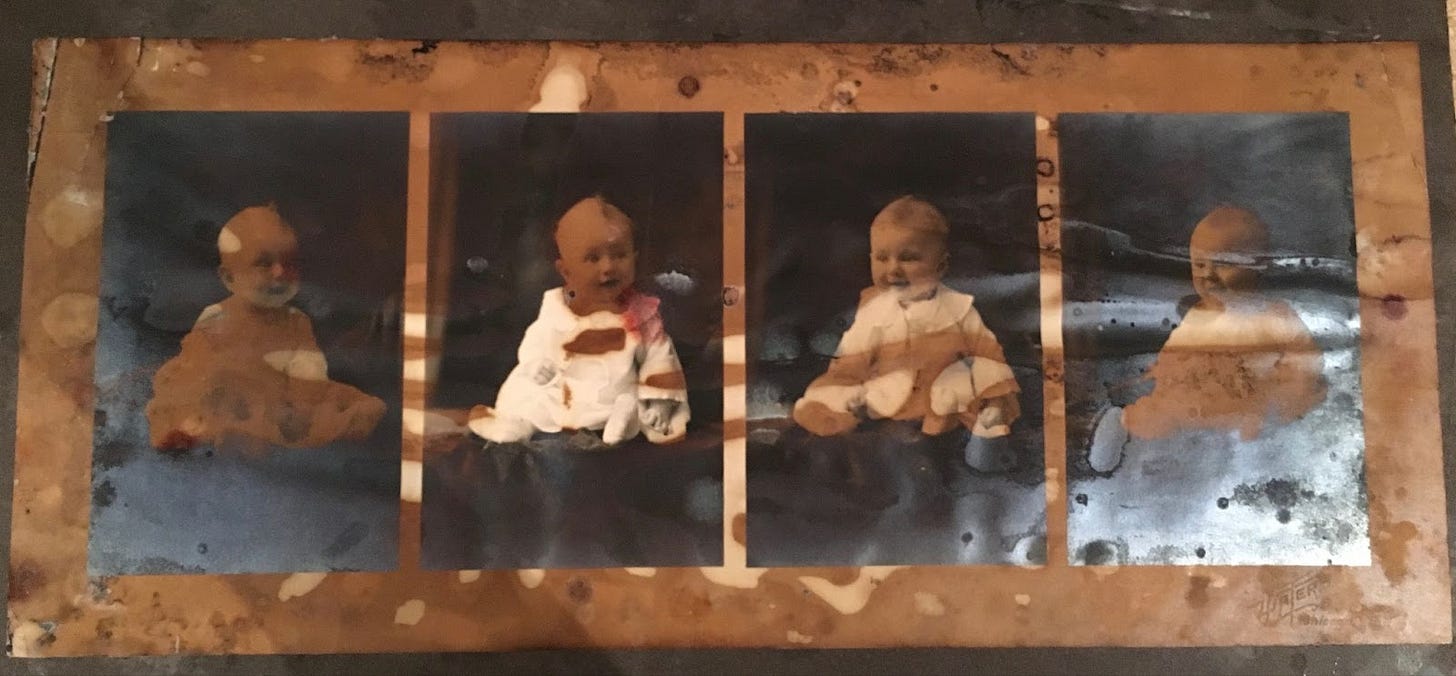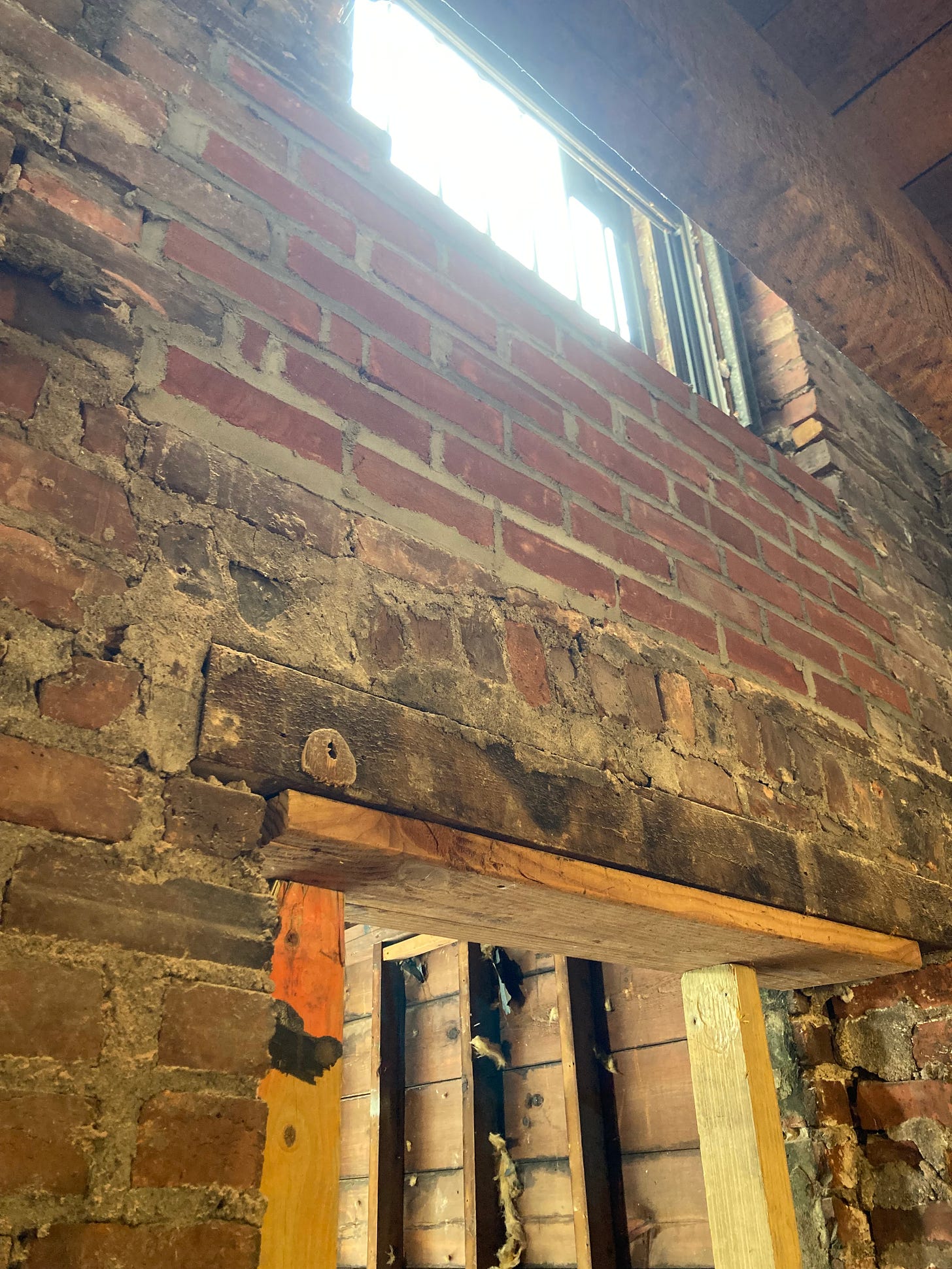After last week’s post about choosing a title for this Substack I’ve decided to try out Option #3. So, at least for now, this is From Life, a reference to my biography of photographer Julia Margaret Cameron and the captions on her images. That said, the image of diving into a wreck is particularly appropriate this week, when I discuss a fragment from my memoir about my father’s art career…. During this “soft launch” I’ll experiment with different content and formats for these posts, but they will all have some connection to memoir.
I do laundry every week but I never noticed the drip before. So it was too late when I realized there was water seeping over and under the piles of papers on the table in my basement. Those papers included:
four photo albums of my father’s family in Chicago, ca. 1920–40.
a random assortment of prints and drawings my father had collected over his years as a picture framer in New York City, from 1980 to his death in 2011.
a scrapbook of advertisements designed by my grandfather, a graphic designer in Chicago for products like Kleenex, Allstate car insurance, and Planter’s Peanuts from the 1920s to 1960s.
loose photos of family members that didn’t fit into the scrapbook or folders, like the 9×12 close up of my father’s brother as a cadet at the Citadel, before he was killed training to become a combat pilot during World War II.
Now that I noticed the water I also noticed the smell — rank as dead leaves.
I threw away my father’s collection of prints and took photos with my phone of the ruined photos, their age newly on display in the mold creeping in from the corners. My father’s brother, Andrew P. Olsen Jr., long dead, was alive with green and black spots. The series of four smiling baby photos (was it my father or his brother?), taken in Chicago in the 1920s and carefully preserved for almost one hundred years, curled into itself as it dried. I tried to save the Indonesian puppet my father moved from his Brooklyn loft to upstate New York, tacked to a wall of his painting studio. Its moveable arms akimbo, it survived better than the photos.
How stupid to leave all that paper in that vulnerable spot, exposed beneath the pipes pulling water through the house. But it was January 2019 and I had a new idea: to write a history of my father’s family, a story of art and advertising in America as my grandfather’s design career rose with consumer culture and as my father defined himself as an artist just as modern art discovered popular culture in the early 1960s, when I was born. It would be a story of a father and a son, American consumerism, Chicago business, and the New York art world. It would explain my grandfather’s and father’s successes and failures, and enable me to write another book after a fifteen year gap, though I still call myself a biographer. Somehow I’d link it to the project I told people I was writing: a biography of the dancer Jane Avril, dancer of the Moulin Rouge in Paris in the 1890s and model for Toulouse-Lautrec. After all, she was a poster girl for art and advertising, wasn’t she? Somehow it would explain how that project had inexplicably stalled and why I didn’t write “for myself” at all any more.
That’s why the photos and papers were all left out on that table. Because I was “working on them.” But now they were soaked through. As pieces of evidence they were changing (and disappearing) before my eyes.
***
I’ve written elsewhere about my basement as metaphor, but it is also a three-dimensional space filled with objects from my past, in various stages of integrity. The fragment above came early in my writing process and was once early in the memoir’s draft too. It sounds like a beginning, but I have to concede that it isn’t dramatic enough for an opening. It doesn’t open any lasting questions or elicit suspense. I confess too, with some embarrassment, that I love those waterlogged images, which is why I include two of them. I regret the damage but the images themselves seem lovely in their new guises, like they have been reborn in some way. The curling edges and splotches of color seem to animate the past.
Since then my spaces have gone another kind of rebirth — or deconstruction, a word I used to associate only with my graduate school English classes but which has become quite literal. During the course of renovating the first floor of our 1899 rowhouse the basement had to be emptied and the foundation reinforced— oh, another metaphor! At this moment in real time the back of my house has been ripped off, its innards exposed to the sky. The walls are speckled and uneven, with layers of peeling paint and broken bricks. The photo above, taken a few months ago, seems similar in texture to some of my damaged family photos.
The physical renovation has been at least as emotional as my diving into the family wreck. I’ve been displaced from my home, temporarily, and disconnected from the concrete (get it?) evidence of my family's past, with its own suggestions of damage and loss (like the early death of my father’s brother). Today’s essay is an attempt to twist together the separate strands of words, things, and associations to re-create something coherent and stable, like firm ground.
I will leave this post there, or here— and invite your feedback, or your own associations with any of these threads, in the comments below. If you enjoyed this post, please share or like it because that is how word spreads. See you next week!







Woo! What beautiful writing. I feel the physical displacement from home as completely wrenching but having some seeds of liberation.